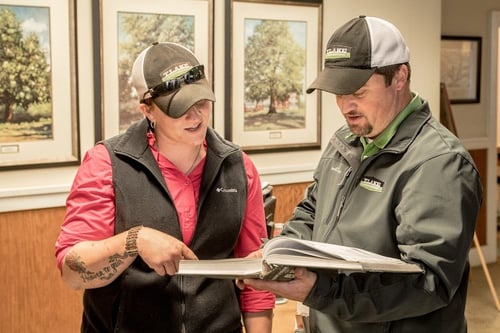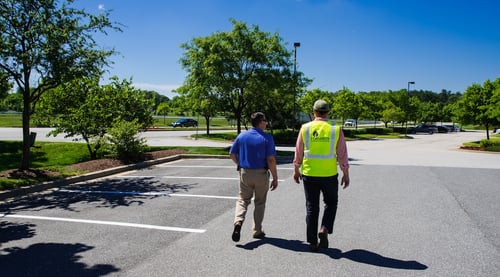 One-on-one meetings are a critical form of communication within your landscape company. And it’s no secret that open and ongoing communication is one of the keys to successful management. Even so, it is safe to say that one-on-one meetings are drastically underutilized within the landscape industry.
One-on-one meetings are a critical form of communication within your landscape company. And it’s no secret that open and ongoing communication is one of the keys to successful management. Even so, it is safe to say that one-on-one meetings are drastically underutilized within the landscape industry.
Jim Cali, executive coach, consultant, speaker, and peer group facilitator with McFarlin Stanford, a management consulting firm based in Dallas, says that he is a big believer in one-on-ones mostly because “they work.”
“One-on-one meetings are your only real opportunity to sit down with your direct reports and understand what’s going on,” Cali says. “It should be viewed as an opportunity not to be missed.”
He says that the main reasons behind why more landscape companies aren’t doing them are three-fold:
- They are failing to make the meetings a priority
- They don’t perceive the value out of what these meetings could mean
- They don’t have the content to make the meetings meaningful.
We asked Cali to address these three issues and to also discuss how landscape business owners can enhance their one-on-ones.
1. Failing to Prioritize One-on-One Meetings
 In order for one-on-one meetings to be truly effective, they have to actually happen. Unfortunately, Cali says that one-on-ones are often the first thing to get knocked off the weekly to-do list as soon as things get busy. However, when companies fail to prioritize one-on-ones, they’ll never make any progress with them.
In order for one-on-one meetings to be truly effective, they have to actually happen. Unfortunately, Cali says that one-on-ones are often the first thing to get knocked off the weekly to-do list as soon as things get busy. However, when companies fail to prioritize one-on-ones, they’ll never make any progress with them.
“Never reschedule a one-on-one,” advises Cali. “Just make it happen. If something comes up that absolutely prevents you from having your scheduled one-on-one that week then reschedule within the current week. Don’t just let another week go by. They must be weekly in order to truly be effective.”
Cali says to put a date on your calendar, in your landscape business software, or wherever else you schedule your weekly tasks—and stick to it. He says that even doing it every other week is not enough. Simply too much time passes in between.
 “When one-on-one meetings are held two or three weeks apart, you’re not doing anything to really push the company forward,” Cali says. “You might talk about tasks that should get done before the next meeting but then all this time passes. Your reports might save them to the very last minute or maybe table them completely as they get busy with other stuff. Even worse, with all that time passing, they might forget. To keep the momentum going these meetings must be weekly. It will keep the business moving forward.”
“When one-on-one meetings are held two or three weeks apart, you’re not doing anything to really push the company forward,” Cali says. “You might talk about tasks that should get done before the next meeting but then all this time passes. Your reports might save them to the very last minute or maybe table them completely as they get busy with other stuff. Even worse, with all that time passing, they might forget. To keep the momentum going these meetings must be weekly. It will keep the business moving forward.”
While one-on-ones in-person are highly preferable if it’s a matter of either canceling the one-on-one or doing it over the phone then Cali says to opt for the phone call.
“The optimal location for a one-on-one is in the office, where there are no distractions and where you can really dial in on what the person is saying,” Cali says. “There’s really nothing better than facetime. However, if it can’t happen in the office because your report is in the field, then don’t cancel it, do it on the phone. Even better, if you want to see how someone does their job, meet them in the field and do it there that week. Just don’t default to canceling.”
2. Failing to Recognize the Value of One-on-Ones

Cali says that another reason that one-on-ones aren’t performed more regularly is that landscape business owners simply fail to recognize just how important they are. However, as a landscape business coach and former leader in a landscape firm, Cali says he can attest to the fact that one-on-one meetings really do work.
“If you don’t do them, you are failing to meaningfully connect and communicate with your reports,” adds Cali. “One-on-ones are important because they build momentum. After the meeting is over, your reports know exactly what you expect of them. In my opinion, there is no better time spent with your direct reports than in one-on-ones.”
Cali says that if more landscape business owners could focus on the fact that one-on-ones build momentum, they’d probably be more apt to do them. After all, momentum is what pushes a company forward toward growth.
“It’s comparable to what a lot of landscape companies do when they perform maintenance,” says Cali. “Every week if you maintain a property, it starts to look better and better over time. But if you were to start skipping weeks, it’s going to look worse. It’s that momentum that really counts. But you have to stick with it.”
3. Lacking Content for One-on-One Meetings
Cali says that content is a key piece of holding one-on-one meetings and a lot of landscape business owners aren’t sure what to cover. They may even think they don’t have any valuable content at all. But Cali says that once you start getting these meetings up and running, the content will come.
“A good place to start is to really dig into what your direct reports are doing,” Cali suggests. “You’ll see you have lots of content. Discussing what they’re doing will give you a lot to talk about.”
Another approach to content is looking at the “past, present, and future.”
 “Talk about what happened last week, what’s happening this week, and what’s happening next week,” he says. “If you’ve done all that and still feel like you don’t have enough content, ask them to show you how to do pieces of their job. You’ll learn a lot when you ask a report to show you what they’re actually doing and how they’re doing it. You can then use that experience to talk about how they can be more efficient or what might make their job easier. There are so many directions a meeting can go from there.”
“Talk about what happened last week, what’s happening this week, and what’s happening next week,” he says. “If you’ve done all that and still feel like you don’t have enough content, ask them to show you how to do pieces of their job. You’ll learn a lot when you ask a report to show you what they’re actually doing and how they’re doing it. You can then use that experience to talk about how they can be more efficient or what might make their job easier. There are so many directions a meeting can go from there.”
Cali also says that one-on-one meetings should always have a “personal element” to them. Never let a one-on-one meeting go by without also using it as an opportunity to get to know your report a little bit better as a person.
“Always make sure that you know the names of all of your direct reports’ spouses and their children,” Cali advises. “Take the time to ask about their families. You could also view this meeting as an opportunity to ‘check in,’ and see how they’re really doing.”
Also, be sure to take notes. One of the best ways to make the meeting valuable and to continue building upon what you’re doing is to take notes and recall them at the next meeting. Landscape business software can be utilized to store these notes.
Cali says that your direct reports should take notes, too. And there should be a quick recap at the end of the meeting. Doing so is mutually beneficial to both you and your direct report, to ensure you’re definitely on the same page.
Who Should Attend One-on-One Meetings?
Supervisors should be using one-on-one meetings to meet with their direct reports, says Cali. If your reports also have reports of their own, they should also be holding one-on-ones.
How many direct reports should you have? Cali says that number is obviously going to differ from company to company but he has some thoughts on what is ideal.
“I personally believe that 8 direct reports make up the optimum number,” he adds. “You should have a minimum of 5 or a maximum of 12. Anything more or less is difficult to manage. If you have 8 reports, that is 8 meetings a week which represents a little over 20 percent of the work week, assuming you work 40 hours. That might sound like a lot to some people but that’s how important these meetings are. I cannot emphasize enough that one-on-ones are the way to move your company forward.”
In terms of whether or not the meeting can two-on-two or three-on-three, instead, Cali says an emphatic No!
“I often have landscape business owners tell me “Well I have these two sales guys so I’m just going to pull them both into the meeting,” Cali says. “It defeats the purpose. That’s a sales meeting, not a one-on-one. You can do your sales meeting—that’s important, too. You should absolutely still be meeting as a team. But it’s not a replacement for the one-on-one with each individual report.”
Keep it Simple, Keep it Positive
 While this may sound like a big task, Cali says that once you have them up and running, it all starts to feel quite natural. And once you begin to see the meetings really pay off, they only become easier to do. While you may have started out feeling as though you didn’t have enough meaningful content, you may very easily reach a point where you have so much content it’s hard to cover it all in a single meeting.
While this may sound like a big task, Cali says that once you have them up and running, it all starts to feel quite natural. And once you begin to see the meetings really pay off, they only become easier to do. While you may have started out feeling as though you didn’t have enough meaningful content, you may very easily reach a point where you have so much content it’s hard to cover it all in a single meeting.
If you’re implementing one-on-one meetings for the first time or trying to improve upon previous attempts to do them, Cali has two closing pieces of advice:
- Keep it Simple
- Keep it Positive
“This should not be a complicated endeavor,” he says. “If you over complicate it, you’re not going to want to do it. And that leads to my final point which is to keep it positive. If you start to exhibit your own negative attitude about doing these meetings, your direct reports will pick up on that negative attitude. At that point, the meeting really becomes useless if neither of you is engaged in participating. Maintain a positive attitude and your direct report will follow suit. In no time, you’ll start to see the benefits pay off.”
If you’d like to use landscape business software to help you record valuable content from your one-on-one meetings, then let’s explore and see what Asset can do for your landscape company.
Image Sources: T. Lake Environmental Design, Level Green Landscaping



